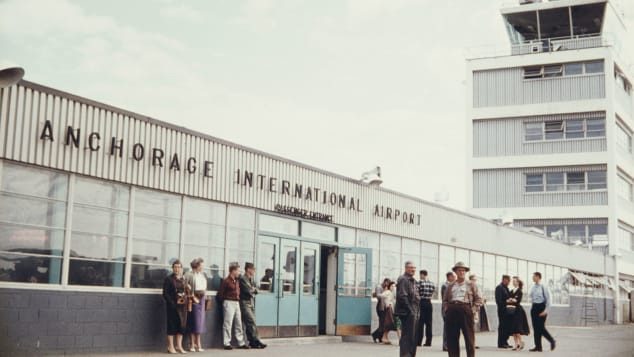Ted Stevens Anchorage International Airport is a regular cargo hub, located roughly equidistant between New York and Tokyo, with a flight time of just 9.5 hours compared to global airlines. With the snow-covered backdrop of the Chugach Mountains in Alaska, serving a city of only 300,000 residents, this airport can be considered one of the best-located airports in the world today.
City of Stopover
Completed in 1951, Anchorage Airport has been a popular stopover for passenger flights from Europe to East Asia for the past 40 years, especially after the Cold War severely restricted flights over the Soviet Union.
As international relations began to “thaw” in the 1990s, airlines were finally able to exploit more economical and direct routes across the vast expanse of Russia, allowing them to cut costs, reduce flight times, and lower fares.

Image of Anchorage International Airport around 1965. (Photo: Getty).
Thus, Anchorage has stabilized its current role as a major hub for cargo traffic and a modest airport serving seasonal passenger flights. Today, it handles approximately five million passengers each year.
However, when the coronavirus pandemic struck in early 2020, Anchorage became a global focal point, playing a crucial role in the international transportation of essential medical supplies. It even became the busiest airport in the world for a short period.
While global passenger traffic plummeted by over 90%, “We saw a demand for increased cargo capacity,” airport director Jim Szczesniak told CNN Travel in April 2020. “And that was primarily due to a lot of supplies for the fight against Covid in North America being produced in Asia.”
Aircraft “fly up and over the top of the globe to shorten the distance,” he explained. “The advantage of Anchorage is that planes can carry a full load of cargo but only refuel halfway. They fly into Anchorage, refuel, and then head to their destination.”
Record Air Cargo Volume
At the peak of the pandemic, Anchorage Airport was handling nearly 130 wide-body cargo flights each day and had to utilize new areas of the airport for parking.
In 2020, it also hosted the heaviest aircraft ever built, the Antonov An-225 Mriya cargo plane.
But by 2022, the airport’s operations director, Trudy Wassel, told CNN in early March that 115 wide-body flights per day had become the “new standard.” Wassel stated that this number equates to about 300 hotel rooms for cargo transport teams each night.
Anchorage is home to UPS and FedEx hubs, and the strengthened supply chain means that the airport is witnessing record air cargo volumes for the second consecutive year.
It handled approximately 3.6 million tons in 2021 alone, and about one in ten jobs in Anchorage is connected to the airport.
Wassel informed CNN that the airspace over Russia is ready to adapt if carriers need to use the airport due to the current situation, “We are well aware of what is happening in the world, and we are waiting.”
“We are working internally to ensure that operationally, we have the infrastructure to handle when and if we receive requests from carriers to come through Anchorage.”
This involves preparing for any operational needs of airlines.
“For example, an airline may need a technical stop, meaning they will only refuel, possibly change crews, and then depart?” Wassel said. “Our ground handling staff can turn an aircraft around in about an hour and 40 minutes, depending on the airline’s needs. Or these airlines may pass through Anchorage and require additional services.”





















































